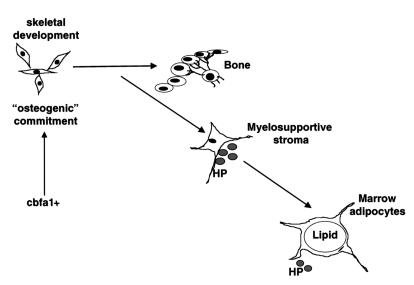Figure 1.
During development, precursor cells become committed to skeletogenesis upon induction of the critical osteogenic transcription factor, cbfa1. The initial phenotype expressed by these cells is that of fully mature osteoblasts. Subsequently, when a threshold amount of bone has been formed, these cells form the primitive bone marrow stroma that serves as the bed upon which hematopoiesis occurs. At some point during the postnatal period, when hematopoiesis is sufficient, these same cells change phenotype yet again to become marrow adipocytes. Cells of these three phenotypes (osteoblastic, myelosupportive, and adipocytic) form a continuous network throughout the bone–bone marrow organ and maintain expression of cbfa1. These differentiated cells are able to shift from one phenotype to another, depending on the metabolic status of the organism.

